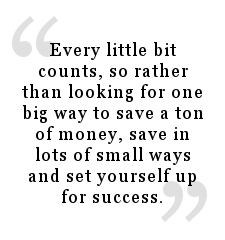
Picture this: You’re in line at Target, ready to check out—and somehow you have a cart full of stuff when all you came for was toothpaste and face wash.
You know you don’t really need all those other things, but the yoga pants, flower socks, hair wrap, and holiday table linens were just too cute to pass up.
Sound familiar?
Chances are, if you’re like most modern working women, you know you need to save money
for the future—yet somehow there’s never any money left at the end of the month.
So instead of constantly beating yourself up for not saving every month, learn this simple approach and then spend money guilt-free—a win-win solution.
The old way of managing money
every month was to pay your bills, spend your money on fun things like going out and shopping, and then save whatever was leftover.
Old Way: Save What’s Left Over
Net Income (after-tax income)
-Bills
-Spend money on fun things
=Save whatever’s leftover
This approach never works long-term.
It’s just too hard to save money at the end of the month when we live in a world of immediate gratification.
So stop making it so hard.
Simply shift your mindset and follow the new approach to managing money: The “Pay Yourself First” strategy.*
New Way: Pay Yourself First
Net Income (after-tax income)
-Bills
-PYF Savings (Cash cushion, retirement, travel goal)
=Spend money on fun things (guilt-free!)
Automate your savings so they’re just like another bill that you must pay every month.
After you pay your bills and Pay Yourself First, you can spend the remaining amount of money on whatever you want, guilt-free.
If you want to go to Target and spend $150, go for it. Or maybe you want to buy that new designer bag that costs a lot of money.
Do it.
You may have to eat ramen noodles the rest of the month, but at least now you’re being a smart, financially wise woman who is saving first and spending last.
Of course, you can’t spend more than what’s left over every month, otherwise, you’ll be creating debt–and we know that’s not good.
How much should I be saving?
A good rule of thumb is to save 10-20% of your net income toward your top three financial goals for the year.
However, if that’s too much for you, start small. Maybe start with 3% and work your way up by increasing the percentage by 1% every six months until you reach the desired level of 10-20%.
Take Action
This approach sets the foundation for your financial success long-term.
It makes it super easy for you to save money and not feel guilty about spending what’s leftover.
So now it’s your turn.
Work on setting up your Pay Yourself First strategy and start saving the easy way.
Set up automatic savings toward at least one of your financial goals today.
This could be as simple as putting $50 per month into your savings account to build your cash cushion. Or it could be contributing $100 per month into your Roth IRA.
Whatever it is, just make it automatic.
You’ll be surprised at how you won’t even miss that money once it’s automatically deducted.








